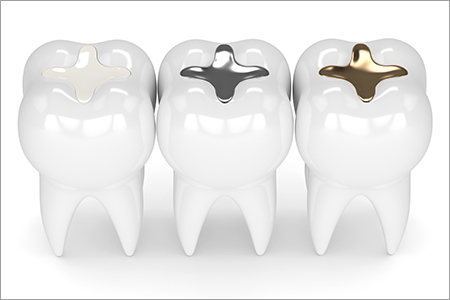Dental Fillings

Learn more about different types of Dental Fillings and Restoration Services
Amalgam Fillings
Over time amalgam fillings absorb moisture and swell causing the edges of the filling to break away. This allows food and bacteria to get trapped in spaces and cavities to form. When we recommend replacing a worn silver filling we take into consideration the amount of healthy tooth structure that remains. Often we can replace a small filling with a tooth colored one that is bonded to the tooth. If your worn filling is fairly large and less natural tooth remains we recommend a full coverage restoration like a crown to strengthen what remains of the tooth and restore its function
One disadvantage of amalgam is that these types of fillings are not natural looking, especially when the filling is near the front of the mouth, where it may show when you laugh or speak. Also, to prepare the tooth, the dentist may need to remove more tooth structure to place an amalgam filling than for other types of fillings.
Gold (Inlay) Fillings
Gold fillings, also called inlays or onlays, are composed of an alloy of gold, copper and other metals.
This type of dental filling is usually considered the most durable, lasting 20 years or more, but it is also the most costly. Gold fillings also require more than one office visit to place because they require impressions to manufacture at a dental laboratory.
Tooth Colored Fillings or Composite Fillings
Composite resins, or tooth-colored fillings, provide good durability and resistance to fracture in small- to mid-size fillings that need to withstand moderate pressure from the constant stress of chewing. They can be used on either front or back teeth. They are a good choice for people who prefer that their fillings look more natural.
Composites cost more than amalgam and occasionally are not covered by some insurance plans. Also, no dental filling lasts forever. Some studies show that composite fillings can be less durable and need to be replaced more often than amalgam fillings.
It generally takes longer to place a composite filling than it does for a metal filling. That’s because composite fillings require the tooth be kept clean and dry while the cavity is being filled. Tooth-colored fillings are now used more often than amalgam or gold fillings, probably due to cosmetics. In a society focused on a white, bright smile, people tend to want fillings that blend with the natural color of their teeth.
Ultimately, the best dental filling is no dental filling. Prevention is the best medicine. You can dramatically decrease your risk of cavities and other dental diseases simply by:
- brushing your teeth twice a day with fluoride toothpaste that doctor recommends for your mouth/needs
- flossing daily and cleaning the spaces between your teeth
- eating a balanced diet and reducing the frequency of snacks + drinks high in sugar / pH Acid
- visiting the dentist regularly based on their recommendation for frequency or at least twice a year



